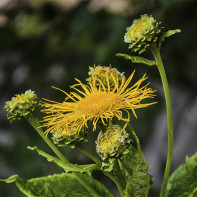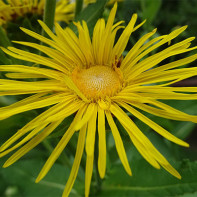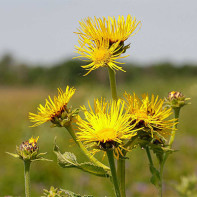Elecampane: medicinal properties and contraindications
Elecampane is a medicinal plant known to people for a long time. There are references to the fact that Hippocrates himself used it for medicinal purposes. Old Russian beliefs say that this plant has exactly 9 forces, hence its name came from. When crossing the Alps, Suvorov ordered his soldiers to be given a decoction from its roots in order to strengthen their forces before the upcoming campaign. Also in the old days it was believed that the drug is able to restore potency and strengthen the heart. It was noted that the plant improves mood, and the infusion of flowers relieves the symptoms of intoxication.
- Chemical composition
- How it looks and where it grows
- Kinds
- Collection and storage
- Medicinal properties of elecampane
- For women
- For men
- During pregnancy
- For kids
- When losing weight
- Elecampane in folk medicine
- With diabetes
- With pancreatitis
- With gastritis
- For the intestines
- With colitis
- For the liver
- With hemorrhoids
- With cystitis
- From prostatitis
- Against cough
- With bronchitis
- With arthrosis
- With a cold
- From parasites
- For immunity
- With protrusions
- In oncology
- Types of healing compounds
- Infusion
- Tincture
- Decoction
- Tea
- Ointment
- Butter
- Elecampane Pharmaceuticals
- "Elecampane-P"
- Root powder
- Syrup "Nine Forces"
- Cream balm "Elecampane"
- Elecampane essential oil
- Herbal tea "Elecampane root"
- Application in cosmetology
- Contraindications
Chemical composition
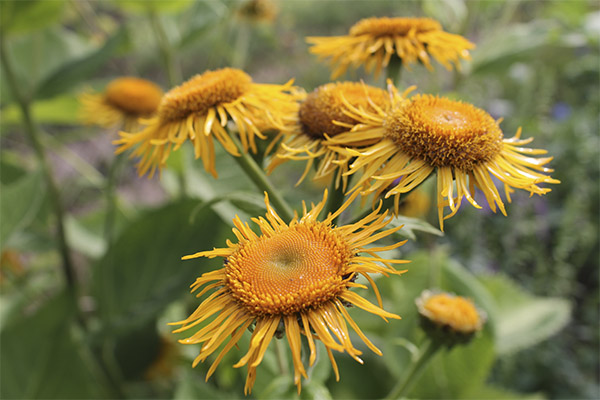
The roots of the plant contain inulin in large quantities (40–44%). This is a very useful substance, it can be called a separate type of fiber. Its peculiarity lies in the fact that, getting into the intestines, it increases the volume of contents, which causes a laxative effect. It is very useful for people who have a tendency to constipation, as it allows you to quickly and efficiently cleanse the intestines. Inulin is also a natural probiotic. When it enters the intestines, it becomes food for bifidobacteria. Thus, inulin improves the absorption of calcium and magnesium, and also removes excess cholesterol from the body. The plant contains essential oils, resins, alkaloids, group E vitamins and ascorbic acid.
In addition, there are sesquiterpenes in the roots, such as alantolactone and dihydroalantolactone.
How it looks and where it grows
Elecampane belongs to the family of Asteraceae. It can grow up to 3 m in height, has large yellow flowers and large dark leaves. Outwardly, it resembles a shrub, the main part of the foliage is concentrated below, while the flowers stretch on stems with smaller leaves up. Elecampane likes to settle in the steppes, fields and ravines, which are located near water bodies.
Kinds
At this moment, several main varieties of the plant are distinguished:
- Elecampane tall. This is the most common type, it has healing properties. From the roots of this plant make infusions and decoctions. It was not for nothing called high, because in some cases it grows up to 3 m. The leaves of such a large plant can have a length of up to 50 cm, and flowers - 7-8 cm. Summer residents often plant it in their gardens. From a great distance it can even be confused with a sunflower.
- Elecampane loosestrife. The leaves of the plant are narrow, no more than 12 cm long. The height of the plant does not exceed 70–80 cm. Unlike the tall elecampane, this plant does not look like a bush, the leaves are thinned out and grow only along the stems. Inflorescences can be lonely, but sometimes they are collected in 2-3 pieces.
- Elecampane British. It occurs in Europe and Asia in large quantities in swamps, along roadsides and in forests. Leaves of this species are lanceolate, but sometimes oval. They have a heart-shaped base that surrounds the stem. The stems with flowers are erect, reaching a length of up to 60 cm. The leaves are quite large and collected in shields.
Collection and storage
When collecting medicinal raw materials in nature, it is important to adhere to all the rules and features.First you need to make sure that this is really elecampane, because an error in the collection of a plant can lead to poisoning, and in the worst case, to more serious health problems. You also need to make sure that along with the roots of elecampane, parts of other plants do not come across. It is recommended to collect it away from roads, in places where it grows most intensively.
You can collect medicinal raw materials twice a year. The first opportunity is provided in the spring, after the appearance of the first leaves on the plant. If you could not collect the roots during this period, then you can catch up on the fall. But it is important to catch up to the first night frosts. For medicinal purposes, you need to dig up plants that are more than 2 years old, together with the root, and then trim the upper part. Then thoroughly shake off the ground and rinse with water. Also trim the outgoing roots whose length does not exceed 5 mm. Cut the remaining roots into pieces of 10-15 cm.
Before drying the roots, they must be left for some time against the sun. Usually 3 days is enough. You can dry the roots in the oven, but the temperature inside should not be more than 40 degrees. But it’s best to dry them in the attic. It can also be stored under a canopy, the main thing is that the plant is well ventilated. It is possible to determine that the raw material is ready by thin roots. They break without much effort and have a white-yellow tint on the scrap, and the main part of the root remains solid.
Quality raw materials have a slightly bitter taste. It also has a pleasant aroma. It is advisable to store the plant in paper boxes, but for this purpose, wooden containers and small fabric bags are suitable. The healing properties of the plant are maintained for 3 years.
Before use, it is important to inspect the raw materials for rodents or insects. In case of detection of their traces, it is forbidden to use the plant. There should also be no extraneous odors, they indicate improper storage or low quality of the feedstock.
Medicinal properties of elecampane
The roots of elecampane are a very useful medicine, because they contain a large number of different substances. The roots of this plant are widespread in folk medicine, they are used to treat a large number of diseases. It is used as an expectorant, anti-inflammatory and antimicrobial agent. Due to these properties, it is often used to treat the upper respiratory tract in collections with other plants. Elecampane is able to normalize the metabolic process and increase appetite.
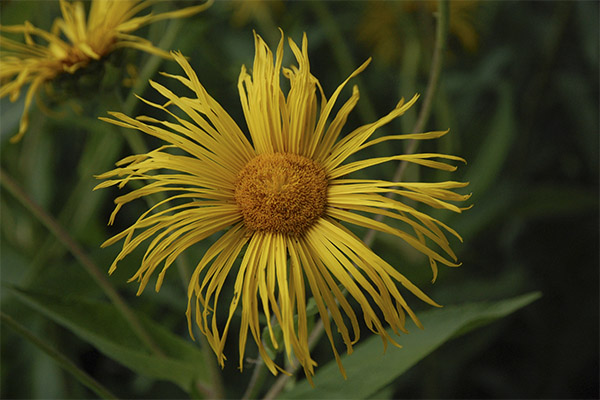
The roots are also used to treat diseases of the gastrointestinal tract and various wounds with ulcers. No less effectively, the roots cope with the treatment of some gynecological diseases. Decoctions and infusions are able to save a person from worms. Elecampane effectively copes with kidney diseases, flu, and viral ailments. Elecampane-based medications are given to people with colitis and stomach ulcers. It will be useful even for sexually transmitted diseases.
For women
The roots of elecampane are often used in gynecology. In ancient times, women were given infusions from the roots of elecampane to get rid of pain in the uterus. It was also recommended for delaying the menstrual cycle, which is associated with inflammatory processes in the genitourinary system or physiological characteristics of a woman. Vitamins of group E contained in the roots of the plant are very useful for the female body. This vitamin plays an important role in maintaining the immune system, skin and hair in a healthy condition. It is a natural antioxidant that protects the structure of cells from damage. It is also sometimes called the "vitamin of beauty and youth." It rejuvenates the skin and promotes rapid tissue regeneration in the body.
Baths and decoctions from the roots of this plant contribute to the healing of wounds and acne. They remove inflammation from the skin and cleanse the pores.
For men
For many years now, dried elecampane root has been used to treat infertility in men.And this tool is really effective, because it contains substances that not only increase the speed of movement of sperm, but also improve their characteristics. In addition, the root of elecampane successfully copes with diseases of the genitourinary system. The drug enhances potency and is very important for men's health.
Elecampane root is also used to treat hemorrhoids. This is a very effective tool that helps relieve inflammation, pain and stops bleeding. And the laxative effect of the drug makes the bowel movement less painful.
During pregnancy
Ingest elecampane during pregnancy is prohibited. Even in ancient times, people noticed that with this medicinal plant you can terminate an unwanted pregnancy. Its root contains phytohormones, which can cause uterine bleeding, which will lead to termination of pregnancy. High levels of vitamin C provoke the activity of sex hormones and cause delayed menstruation. However, do not forget that the delay in the cycle can occur due to serious diseases in the body, and self-treatment will only make it worse.
During pregnancy, it is allowed to use only ointments based on elecampane in small quantities and in emergency situations.
For children
Children can use the grass with the permission of the attending physician and with the exact observance of the dosage. The plant is able to actively fight cough, it is an expectorant and anti-inflammatory agent. Tea from elecampane root has a restorative effect, strengthens the immune system and perfectly protects the body from viruses and bacteria.
When losing weight
Elecampane will be an excellent tool for the prevention of diseases and healing the body. It is recommended to add it in dietary foods in small quantities. Equally, he is able to increase appetite and lower it. The effect depends on the method of preparation and administration of the plant. To reduce appetite, you need to pour 1 tbsp. a spoonful of crushed root with a glass of cold water. Already on the third day of admission, the effect will become noticeable.
Elecampane in folk medicine
This drug is able to treat a large number of diseases. Its use is quite diverse, and it all depends on the dosage and method of preparation. However, you need to use it very carefully. Before starting treatment, it is advisable to first consult with your doctor.
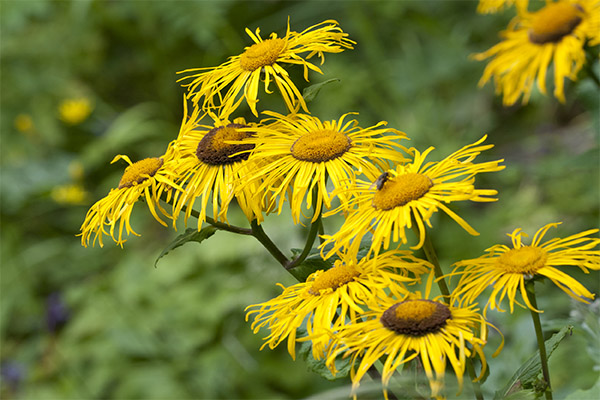
With diabetes
Diabetes requires a complete diet review. Sick people should follow a strict diet, deviation from which is fraught with serious consequences for the body. In addition to the main therapy, elecampane can act. It is often used in folk medicine for diabetes.
To prepare medicinal raw materials, 2–4 teaspoons of raw materials and a glass of cold water will be required. Grind the roots thoroughly and add water. It is important to use boiled water. Then leave the poured medicine at room temperature for 3-4 hours, and then cook in a water bath for 20 minutes. Strain the broth and pour it into a warm bath when bathing.
With pancreatitis
Elecampane contains vitamin E and the alkaloids that the pancreas needs. The roots act as a regulator of the nutritional activity of the body. This plant is one of the components of the collection, which is useful to drink with pancreatitis. Also, this herb is in the ranking of plants that are beneficial for the stomach. Some drugs that are prescribed to people with pancreatitis contain elecampane root. One such drug is Alanton. But in no case should you self-medicate.
With pancreatitis, you can take a decoction of 2 tbsp. tablespoons, 1 tbsp. spoons of elecampane and 1 tbsp. spoons of coltsfoot. Chop the herbs, mix and fill with water (0.5 L), then boil for 5 minutes, then cover and leave to infuse for 1-2 hours. Take the entire volume of fluid throughout the day in small sips.
With gastritis
With gastritis with reduced acidity of the stomach, elecampane should not be taken. The fact is that this plant can reduce the amount of secreted enzymes in the stomach, which threatens with serious consequences for the body with low acidity. Patients are advised to consume in small quantities wine from elecampane, which, in contrast to decoctions and infusions, increases acidity. With increased acidity, it will be useful to take both decoctions and infusions.
For the intestines
Elecampane is one of the best traditional medicine to keep your intestines healthy. In laboratory conditions, it was found that the substances contained in it contribute to better absorption of useful components. This tool is a natural probiotic, so its benefits are undeniable.
Elecampane is an effective remedy for constipation and fights against worms. It can sometimes be taken for prevention. 1 teaspoon of crushed raw materials pour a glass of boiling water and insist for at least 10 hours. Then consume a quarter cup before each meal. This is a universal recipe for various bowel diseases, constipation and even indigestion.
With colitis
Colitis is one of the most common bowel diseases. It is believed that it is quite difficult to treat it. Colitis can appear even after harmless enemas, and if you do this procedure for chronic pathology, you can cause an exacerbation. The source of infection in the body or the same type of food can become the cause of the disease. Often the cause is alcohol abuse. In addition to the main course of treatment, herbs can be used. Elecampane is ideal for these purposes, it can be taken as a collection with other herbs, or as a separate tool.
At 2 tbsp. tablespoons of crushed root need 0.5 liters of water. Pour elecampane in a thermos with boiling water, cover and insist for 4 hours. Then strain and drink 2 tbsp. tablespoons thrice a day.
For the liver
It is known that elecampane is a good choleretic and bile-forming agent. In clinical settings, it has been proven that allantoin in the roots helps to cure many liver diseases. Elecampane lowers the amount of pepsin in the stomach, which has a beneficial effect on the liver. To treat liver problems, a herbal collection is used, which includes elecampane (150 g), burdock (550 g), dandelion (450 g), immortelle (450 g), artichoke extract (150 g) and stigmas of corn (300 mg). Grind each component to a powder state, then mix thoroughly. Pour 1-2 teaspoons into a glass of boiling water, let it brew and take 2 times a day.
However, one does not need to be diligent with this collection and accept it unnecessarily. It is advisable to consult a doctor before use.
With hemorrhoids
The causes of hemorrhoids can be different. For example, it sometimes appears in women after childbirth. Also, constipation, circulatory disorders or chronic inflammatory diseases of the intestines or digestive organs are often the cause of hemorrhoids. This disease causes severe discomfort. But elecampane effectively copes with it thanks to a laxative, anti-inflammatory and antimicrobial effect. The drug also improves blood circulation.
For treatment, 1 teaspoon of the root and one glass of warm water will be required. Elecampane root to grind to a powder, then pour a glass of boiled water. Insist for at least 5 hours, then strain the liquid through a small gauze. Ready to take infusion 20-30 minutes before eating 50 ml 4 times a day.
Another recipe does not require the preparation of infusion or broth. It is necessary to grind to a state of powder a small amount of elecampane root. Take it in its pure form, 2 g before each meal, but no more than 3 times a day, washed down with water.
With cystitis
Cystitis is an inflammatory disease of the bladder that develops as a result of infection in the kidneys or urogenital system. Signs of this disease are frequent and painful trips to the toilet. Also, patients find in the urine impurities of blood or pus.Elecampane root has anti-inflammatory and antimicrobial effects, therefore, it is able to treat this disease. For treatment, you need a decoction of the roots of elecampane. Grind 2 tbsp. tablespoons of dried roots, pour a glass of hot water, then cook in a water bath for another half an hour. Next, cool and strain the broth. Drink the medicine 20 minutes before eating 1/2 cup, but not more than 3 times a day.
From prostatitis
Mature men often experience this disease. Inflammatory processes develop in the prostate gland, which may be caused by infection. Identifying this disease is not so simple. Firstly, it quickly flows into a chronic form, and secondly, most men prefer to sit out during a period of exacerbation at home. During an exacerbation of the disease, chills, fever can be observed.
Elecampane is one of the best drugs not only for the intestines, but also for the genitourinary system. It effectively removes inflammation, and destroys foci of infection. Broth is the most effective for the treatment of prostatitis. It is necessary to grind 2-3 teaspoons of the raw material to a powder and pour 0.5 l of boiling water, then cook in a water bath for at least half an hour. Cool and strain the broth. Drink every 2 hours for 1 tbsp. spoon during the day. Before use, be sure to slightly warm the broth.
Against cough
Elecampane is able to treat any cough, including the common cold. In addition, the root strengthens the immune system, which contributes to a speedy recovery. To get rid of a cough, you can even use a raw root. To do this, you must first clean it from the top layer, then cut into medium pieces and dissolve one at a time three times a day. However, it is worth remembering that this remedy is effective against mild cough in the initial stage.
With a stronger cough, a decoction is required. It can be drunk or inhaled. It will take 1 tbsp. spoon chopped into small pieces of root and a glass of boiling water. Pour root water, then boil in a water bath for 30 minutes. Cool the broth, strain, then dilute with warm water to the original volume. Drink the whole glass throughout the day in any portion. You can increase the effectiveness of the product by adding a spoonful of honey to it.
When using this decoction for inhalation, it will be necessary to proportionally increase the amount of raw materials and water. You can also add to the decoction and other herbs. Breathe the steam for no more than 15 minutes.
With bronchitis
Elecampane has been used for the treatment of bronchial tubes since ancient times. This is a very powerful drug that dilutes sputum and helps to eliminate it. It destroys microbes that can cause bronchitis. With bronchitis, both decoctions and infusions are used. To prepare the infusion, you need 1 teaspoon of chopped roots and 1 liter of boiling water. Pour boiling water over the medicine, then insist for at least 20-25 minutes. Every day you need to drink 3 glasses. It is recommended to add honey in addition.
To prepare the broth, you need 1 tbsp. a spoon of plants and 200 ml of water. Pour raw materials with hot water, then leave to boil for another 15–20 minutes. Insist the broth for several hours, take 1 tbsp. spoon three times a day, preferably before meals. Such a decoction is an excellent expectorant.
Fresh elecampane root can help treat asthma and bronchitis. Squeeze juice from the root, this can be done using a juicer, then mix with honey in a 1: 1 ratio. Take the medicine for 1 teaspoon 20 minutes before meals 2-3 times a day.
With arthrosis
In old age, joint pains become a faithful companion of a person. When neglected, this disease often causes disability in people, especially arthrosis of the knee joint. Often the only way out is the operation, however, due to the age or characteristics of the body, there is no chance of its successful completion. However, people have long used folk remedies for the treatment of arthrosis. One of the main functions of pain medications for arthrosis is the removal of inflammation, so the use of elecampane is justified.
For the treatment of joints, alcohol tincture is required. For 100 g of dried roots, take 250 ml of alcohol. It is advisable to prepare an infusion in a glass container, it can be an ordinary jar. Pour the crushed root with alcohol, then cover and put in a dark place for 14 days. Ready raw materials will be enough for a long time, tincture to smear diseased joints every day before bedtime. It is recommended after applying elecampane to wrap a sore spot with a woolen cloth.
With a cold
When a person gets cold or flu, he immediately remembers lemon and garlic. These funds have long established themselves as the best helpers against these ailments. However, few people know about elecampane, although it is not inferior to the aforementioned means of effectiveness. Unlike garlic, with its unpleasant odor, you can use elecampane even at work. To do this, you need to clean and cut the roots in advance, then dissolve one piece three times a day during the day. Elecampane has a pronounced bactericidal effect, and after a short period of time it will become easier.
Also, with a cold, you can use a decoction. It is necessary to mix the root of elecampane and angelica 1 tbsp. spoon, grind thoroughly, mix, then pour them 1 liter of hot water and boil for 10 minutes. Cool, strain and consume 100 ml throughout the day, preheating.
From parasites
According to the World Health Organization, intestinal parasites cause 16 million deaths per year. It is important to timely diagnose the infection and take the necessary measures. In people infected with parasites, weight loss is observed, skin problems, malfunctions of the internal organs can occur. But often the symptoms of infection are similar to the clinic of other diseases, so you do not need to make a diagnosis yourself, it is better to trust professionals.
Elecampane is used to treat parasites that live in the intestines, blood or lungs. Most effective, he shows himself in the collection with other herbs. One of the most popular gatherings consists of elecampane, tansy, St. John's wort, thyme, eucalyptus, burdock and centaury. It will take 30 g of each herb. They need to be carefully chopped and mixed, stored in any container that closes. To prepare one serving, take 75 g of the collection, pour 300 ml of boiled water, then boil for 7-10 minutes, then insist for at least an hour. Add 25 g of honey to the broth, take the drug after meals, 4 tbsp. tablespoons thrice a day. One course of treatment lasts up to 2 weeks, for a complete cure, a minimum of 3 courses will be required.
For immunity
In the period of cold weather, it is very important to prepare the body for the flu and SARS and strengthen the immune system in order to avoid the disease in the future. Elecampane root will fill with strength and increase the protective functions of the body. In order to strengthen immunity, you need to drink a decoction. Pour 1 teaspoon of the root with a glass of hot water, then boil over low heat for 10 minutes. Cool the tool, strain and drink 1 tbsp. spoon 4-6 times a day. Such a decoction very well helps to fight sore throat.
You can also take tea from the roots. Approximately 50-60 g of crushed raw materials pour 1 liter of boiling water, leave for at least 10 minutes, then strain. Drink 100 ml before meals. Ready tea is bitter, so you can add honey. It will not only sweeten the drink, but also enhance its effectiveness.
With protrusions
People say that protrusion is not at all scary, and it does not need to be operated on. But in reality this is a serious problem. Protrusion of the intervertebral disc can be called the first symptom of a growing hernia and osteochondrosis. It is at this stage that patients begin to worry about constant back pain. Do not let the disease drift, you need to see a doctor. In some cases, surgery may be required, in others, the doctor will prescribe drugs.
One of the folk remedies for combating this disease is an ointment from the roots of elecampane. To prepare it, mix 1 tbsp. a spoon of powdered roots from 4–5 tbsp. spoons of bacon. Boil the mixture for 10-15 minutes and strain through any tissue until the ointment has cooled. Lubricate problem areas until the desired result appears.However, it is worth remembering that the ointment can relieve pain, but it alone will not be enough for treatment, you need to consult with your doctor.
In oncology
The roots of elecampane are able to comprehensively affect the human body in this difficult period. Elecampane can be a useful addition to the main course of treatment. To maintain a healthy body, an infusion of honey is used. To prepare it, you will need to grind 1 glass of elecampane roots to a powder state. Then mix it with 0.5 kg of fresh honey and mix thoroughly. Close the mixture with a lid and insist for 24 hours. Take an infusion of 1 tbsp. spoon 2-3 times a day before meals.
Types of healing compounds
Each method of preparation of medicinal raw materials activates and supplements certain substances in the composition of the root of elecampane and is aimed at treating a certain range of diseases. For example, tincture of diseased joints requires tincture, and cough - decoction or infusion.
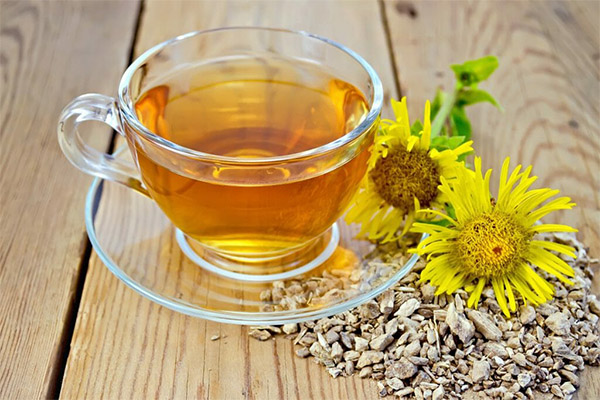
Infusion
Infusion is the best way to treat diseases of the gastrointestinal tract. It has a tonic property, strengthening the immune system. He also effectively fights cough and viral diseases. You can use the infusion and with hypertension. It is also famous for its ability to cleanse the skin from various rashes.
To prepare the infusion, pour 1 teaspoon of the raw materials with a glass of chilled water. It is important to use only boiled liquid. Insist liquid for 8 hours, then strain. Take 20 minutes before a meal, 1/4 cup 4 times a day.
Tincture
Tincture from the roots of elecampane also works well for the treatment of the stomach and intestines. It improves the digestion process and appetite. In addition, while taking tinctures, the metabolism improves, which will be useful for people suffering from excess weight. It relieves inflammatory processes in the joints, thereby relieving pain. Also, tincture is often used to treat diarrhea. The drug does not disregard the liver, has a bile-forming and choleretic effect. For coughs and colds, this medicine can also be used. In addition, it is the tincture that is most often used for external use from acne, acne and other skin problems.
For the preparation of tinctures on vodka, you need 1 tbsp. spoon of raw materials and 0.5 liters of vodka. Pour the raw materials into the bottle, mix and carefully cork. Then place in a dark place for 14 days, shaking it at least once a week. For external use, you can make the tincture a little more concentrated. Then mix the roots of elecampane with vodka in a ratio of 1:10.
It is advisable to use tincture only with the permission of a doctor. She has a number of contraindications associated with pregnancy, heart and vascular diseases. Also, it can not be used even for external use for children under 16 years of age.
Decoction
Broth is most often used to treat respiratory organs; it effectively fights bronchitis, diluting and eliminating sputum. Makeup lotions for problem skin. Ready broth can be poured into the bathroom to keep the skin young and healthy. It is also good for hair.
To prepare the broth you need to take 1 tbsp. a spoonful of crushed roots and a glass of boiling water. Pour raw materials with water and place in a water bath. You can also cook it over an open fire, but the efficiency will be slightly lower. After boiling, boil it for 7-10 minutes, then turn off the stove and leave the broth for at least another 1-2 hours.
You can enhance the effectiveness of the decoction by adding other medicinal herbs to it.
Tea
Traditional medicine says that if you occasionally eat tea from the roots of elecampane, you can forget about problems such as rheumatism, headache and toothache. Tea serves as a prevention of skin diseases, and is also able to treat existing ones.In addition, it has a tonic effect, it can be drunk to prevent colds and flu. It strengthens the immune system and saturates the body with the necessary substances.
To make tea, you need to grind 1 teaspoon of the roots, pour a cup of boiling water and insist 15 minutes. Take one cup, adding honey, because the tea itself turns out to be bitter. Do not abuse this drink daily, as it is still a drug.
You can also make tea from a collection of herbs. Elecampane goes well with St. John's wort, birch buds, thyme and calamus swamp. Also in the tea you can add rose hips, blueberries or raspberries. Such a collection has a general strengthening effect, but before use it is worth consulting a doctor.
Ointment
In the form of an ointment, elecampane is used to treat skin diseases. It can also be used for joint problems. It is easy to prepare the ointment, you only need a certain amount of elecampane root and butter crushed into powder, but lard can also be used instead. Soften the oil so that its consistency is like sour cream. Then mix with the roots and mix. If you use lard, then you need to cook it with chopped root.
Apply the ointment without rubbing it into the skin with a small layer on the affected areas of the skin. You can enhance the effect of the drug by adding sorrel root to the root of elecampane.
Butter
Oil is used to treat wounds. It can even heal ulcers on the body. To prepare it, you will need 100 g of root, powdered, and 1 liter of sunflower oil. Mix the root with oil and set against the sun for 15 days.
Elecampane Pharmaceuticals
Official medicine approves the use of elecampane for medicinal purposes, unlike some other plants. Moreover, in pharmacies you can find pharmaceutical preparations based on elecampane
"Elecampane-P"
These are cough tablets. They are prescribed for diseases of the upper respiratory tract, digestive tract and kidneys. "Elecampane-P" can be taken for the treatment of various skin diseases.
Root powder
The drug is prescribed for ulcers, liver pathologies and hypertension.
Syrup "Nine Forces"
Strengthens the immune system and increases the overall tone of the body, improves blood circulation, and relieves fatigue after physical exertion, favorably affects the functioning of the urinary system and stimulates sexual function.
Cream balm "Elecampane"
It has a strengthening effect on the body, it is used to treat wounds and burns.
Elecampane essential oil
They are mainly used to treat wounds and ulcers on the body, the drug contributes to their speedy healing.
Herbal tea "Elecampane root"
Helps fight viruses, strengthens the immune system. It is also used to treat cough and asthma. The drug has a pronounced analgesic effect.
Application in cosmetology
Elecampane is able not only to treat a large number of diseases, but also to maintain healthy and beautiful skin. These functions of the drug have been known for a long time, it has always been used to treat acne. In addition, elecampane can restore natural shine and beauty to hair. Thanks to a large set of useful substances, he becomes a faithful assistant to women.
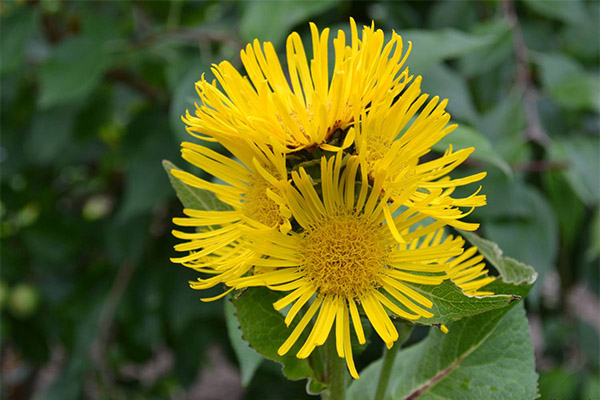
In ancient times, in order to keep the skin clean and healthy, girls washed themselves in the morning with decoctions of the root of elecampane. This procedure prolongs youthful skin and prevents the appearance of wrinkles. The contained vitamins E and C strengthen the structure of the skin, making it supple. Infusion should be done not too concentrated, it will take 1 tbsp. spoon into a glass of water. You can even wash your skin in the morning and evening.
If you mix the crushed root of elecampane with honey, you get an excellent face mask. It should be applied no more than once a week, leaving it on the face for 30 minutes. Then rinse with cold water.The mask cleans pores and skin from acne, blackheads, etc.
You can also give your skin elasticity with a lotion. To prepare it, you need 0.5 l of wine and 50–70 g of crushed roots. Pour the roots with wine and put on low heat for 5 minutes. Then cool the product and apply it with cotton wool to the skin. Store lotion in the refrigerator.
You can strengthen your hair by rinsing it with infusion or decoction from the root of elecampane. This will make them more dense and voluminous, restore their natural shine. Concentrated infusion can help get rid of dandruff. Infusion or broth should be thoroughly rubbed into the scalp, left for half an hour, then rinse with warm water. You can fix this effect of elecampane on the hair, using infusions and decoctions inside.
Contraindications
First of all, elecampane is forbidden to use in the presence of any serious diseases of the cardiovascular system. Uncontrolled use can lead to deterioration and cause serious complications in the future. You can not take this medicine in any form during pregnancy, breastfeeding, low acidity of the stomach. With increased acidity, you can not drink wine-based products. Do not take grass for gynecological problems, as it can cause menstruation. Elecampane lowers blood pressure, so hypotonics should be used with extreme caution.
Even healthy people are advised to first consult a doctor regarding taking medications from elecampane root. Excessive consumption can cause many health problems.
«Important: all information on the site is provided exclusively in fact-finding purposes. Before applying any recommendations, consult with a profile specialist. Neither the editors nor the authors are liable for any possible harm caused materials. "

